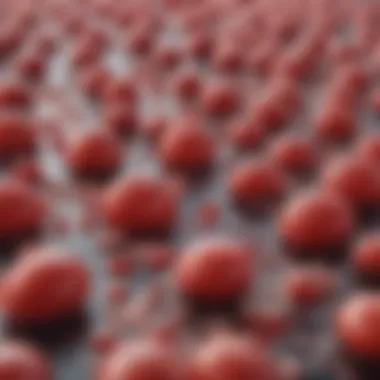Building Red Blood Cells: Insights and Influences


Intro
Understanding the process of red blood cell production is crucial for both health professionals and individuals interested in their well-being. Erythropoiesis, the technical term for red blood cell formation, is a complex yet fascinating subject. It involves a variety of factors, including hormones, nutrition, and lifestyle choices. This article aims to dissect these components, providing an in-depth analysis of how various elements influence erythropoiesis and, ultimately, an individual's red blood cell count.
Background and Context
Overview of the research topic
The production of red blood cells occurs in the bone marrow. This process is tightly regulated by several physiological signals. Erythropoietin, a hormone produced mainly by the kidneys, plays a significant role in stimulating the production of red blood cells. Various external factors can impact both the efficacy of erythropoiesis and the overall health of the hematopoietic system.
Historical significance
The understanding of erythropoiesis has evolved considerably over the decades. Initially, scientists believed that red blood cell production was merely a passive process. Through advanced research technologies, the role of erythropoietin and the hematopoietic microenvironment became clearer. The significance of diet and lifestyle choices also gained attention, leading to a broader comprehension of how to enhance red blood cell production.
Key Findings and Discussion
Major results of the study
Many studies indicate that various lifestyle factors, like smoking or high altitude exposure, may increase the demand for oxygen in the body. This, in turn, enhances erythropoiesis. Conversely, poor nutrition can lead to deficiencies in essential vitamins and minerals required for the formation of hemoglobin, ultimately affecting red blood cell production.
Detailed analysis of findings
- Erythropoietin Regulation: Erythropoietin levels rise in response to low oxygen levels in tissues, prompting increased red blood cell production.
- Dietary Influences: Iron, folate, and vitamin B12 are critical nutrients for red blood cell synthesis. Insufficient intake can result in anemia, a condition defined by low red blood cell levels.
- Lifestyle Choices: Regular exercise improves circulation and oxygen delivery to tissues, which can stimulate erythropoiesis. On the other hand, sedentary lifestyles may hinder optimal production levels.
"A well-balanced diet and moderate exercise can lead to an improved hematopoietic response, optimizing the production of red blood cells."
By understanding both the biological and external factors influencing erythropoiesis, individuals can take informed steps to support healthy red blood cell counts, which directly correlate to better overall health.
Intro to Red Blood Cell Production
The production of red blood cells is a fundamental process within the human body. This section introduces the mechanisms and significance of erythropoiesis. It is essential to understand how red blood cell formation occurs, as it affects many physiological pathways and overall health.
Red blood cells, or erythrocytes, serve a critical role in transporting oxygen from the lungs to the body's tissues. They also carry carbon dioxide back to the lungs for exhalation. The homeostasis of these cells is vital for survival. A deficiency in red blood cells can lead to anemia, causing fatigue and a range of health issues. Thus, understanding the production process can help in addressing various medical conditions.
Defining Red Blood Cells
Red blood cells are biconcave, disc-shaped cells that lack a nucleus. This unique structure allows for maximum surface area to volume ratio, enhancing oxygen transport efficiency. Composed primarily of hemoglobin, these cells bind oxygen and deliver it to tissues throughout the body. The lifespan of a typical red blood cell is about 120 days, after which it is removed by the spleen or liver. This constant turnover necessitates a robust system for production.
Importance of Red Blood Cells in the Body
The importance of red blood cells can not be overstated. They are crucial for delivering oxygen to every cell in the body. This process is vital for maintaining cellular metabolism and energy production. Additionally, they play a part in maintaining acid-base balance. Abnormal levels can lead to serious health consequences, including various types of anemia, fatigue, and decreased immunity.
Moreover, red blood cells act as indicators of health status. For instance, a complete blood count (CBC) test often includes parameters related to red blood cells, providing insight into individual health conditions.
"Understanding the formation and regulation of red blood cells is essential for both medical professionals and patients alike."
The complexities behind red blood cell production highlight its critical nature in biological systems. The following sections will explore the intricacies of this process, including the anatomy involved, nutritional influences, and various lifestyle factors.
The Anatomy of Blood Cell Formation
The anatomy of blood cell formation is critical in understanding how red blood cells are produced and regulated within the body. This section will focus on the main components involved in the process, including hematopoietic stem cells, the bone marrow structure, and the roles of the spleen and liver. Each of these elements plays a significant part in ensuring that red blood cell production is efficient and responsive to the body's needs.
Hematopoietic Stem Cells


Hematopoietic stem cells (HSCs) are the origin of all blood cell types, including red blood cells. These cells reside primarily in the bone marrow and have the unique ability to self-renew and differentiate into various specialized cell types. The significance of HSCs lies in their potential to maintain blood homeostasis. When the body requires additional red blood cells, HSCs can rapidly divide and produce more cells.
Recent research indicates that these stem cells can be influenced by external factors such as inflammation and nutritional status. The following are key points regarding HSCs:
- Self-renewal: HSCs can divide indefinitely, providing a constant supply of new blood cells.
- Differentiation: They can develop into various types of cells including leukocytes, platelets, and red blood cells.
- Niche Environment: HSCs reside in a specialized microenvironment within the bone marrow that supports their functions.
Bone Marrow Structure
Bone marrow serves as the primary site for erythropoiesis, the process of red blood cell formation. The structure of bone marrow includes two types: red marrow and yellow marrow. Red marrow is rich in hematopoietic cells, while yellow marrow consists mainly of adipose tissue and serves as an energy reserve. The transition between these two types can occur depending on physiological demands.
The following features highlight the importance of bone marrow:
- Vascular Supply: The rich network of blood vessels allows for oxygen and nutrients to be delivered efficiently to developing cells.
- Stromal Cells: These support cells provide a matrix and secreting factors necessary for the growth and differentiation of hematopoietic stem cells.
- Extramedullary Hematopoiesis: In certain conditions, like severe anemia, blood cell production can occur outside the bone marrow, primarily in the spleen or liver.
The Role of the Spleen and Liver
Both the spleen and liver are essential for the regulation and recycling of red blood cells. The spleen acts as a filter, removing old or damaged red blood cells from circulation. Simultaneously, the liver plays a role in synthesizing important proteins involved in blood coagulation and is also involved in iron metabolism, which is crucial for hemoglobin production.
Key functions of these organs include:
- Spleen Functionality: Removes aged red blood cells and regulates blood quality.
- Iron Storage in Liver: The liver stores and releases iron by controlling ferritin levels, which affects erythropoiesis.
- Role in Immune Response: The spleen filters blood and helps combat infections, indirectly supporting red blood cell health.
A comprehensive understanding of these anatomical components is fundamental for grasping how various factors influence erythropoiesis. More insights into this anatomy provide the groundwork for applying this knowledge in clinical and research settings, particularly for conditions affecting red blood cell levels.
The Process of Erythropoiesis
Erythropoiesis, the process where red blood cells are produced, is vital for maintaining the body's oxygen supply. Understanding this process allows us to recognize how various factors influence red blood cell levels. Healthy red blood cell production ensures adequate oxygen transport, which is crucial for overall bodily function. This section focuses on the multiple stages of erythropoiesis, the role of the hormone erythropoietin, and the regulatory mechanisms involved in red blood cell production.
Stages of Erythropoiesis
Erythropoiesis occurs in several distinct stages. These stages are essential as they detail the transformation of progenitor cells into fully formed red blood cells. The primary steps include:
- Proerythroblast Stage: The process begins with hematopoietic stem cells transforming into proerythroblasts. These are the immediate precursors of red blood cells.
- Basophilic Erythroblast: Next, proerythroblasts develop into basophilic erythroblasts. Here, cytoplasmic ribosomal RNA increases, resulting in a blue coloration under a microscope.
- Polychromatic Erythroblast: The cells then transition to polychromatic erythroblasts, which produce hemoglobin. The cytoplasm starts to change from blue to a more varied color as hemoglobin production increases.
- Orthochromatic Erythroblast: In this stage, the erythroblast becomes smaller, and the nucleus condenses, preparing for its eventual expulsion.
- Reticulocyte: Finally, the orthocromatic erythroblast discards its nucleus, forming a reticulocyte. This cell still contains some organelles and RNA, which allows for slight protein synthesis.
- Mature Erythrocyte: Within a day or two, reticulocytes mature into fully functional erythrocytes, ready to transport oxygen throughout the body.
Each stage is critical for ensuring the proper formation of red blood cells. Disruptions in any step can lead to anemia or other blood disorders.
The Role of Erythropoietin
Erythropoietin, often abbreviated as EPO, is a key hormone in erythropoiesis.
This hormone is primarily produced in the kidneys and plays a crucial role in stimulating the bone marrow to increase red blood cell production. When oxygen levels in the blood decrease, the kidneys sense this change and release erythropoietin into the bloodstream. The presence of EPO then prompts hematopoietic stem cells in the bone marrow to proliferate and differentiate into red blood cells.
"Erythropoietin is essential for regulating erythrocyte levels in response to oxygen availability."
The effects of erythropoietin highlight the body's ability to adapt to varying oxygen demands, showing how critical it is during events like high altitude exposure or during recovery from blood loss. Understanding the role of EPO helps comprehend how medical treatments can utilize this hormone to aid individuals with anemia or compromised red blood cell production.
Regulation of Red Blood Cell Production
Red blood cell production is a highly regulated process. Several factors contribute to this regulation, ensuring that oxygen levels remain optimal in the body:
- Oxygen Levels: Low oxygen levels in tissues stimulate erythropoietin production.
- Nutritional Status: Deficiencies in iron, vitamin B12, and folate directly impact red blood cell synthesis.
- Bone Marrow Health: The bone marrow's condition affects its ability to produce red blood cells effectively.
- Hematological Disorders: Conditions like anemia and thalassemia alter production rates and affect overall health.
Dynamic interactions among these elements maintain equilibrium in red blood cell production. Recognizing this regulation allows for better management of conditions that lead to abnormal cell counts, guiding effective nutritional and medical interventions.


Nutritional Factors Affecting Red Blood Cell Production
Nutrition plays a crucial role in building and maintaining healthy red blood cells. The body requires specific nutrients to ensure efficient erythropoiesis. Understanding how these nutritional components affect red blood cell production can lead to better health and vitality.
Iron-Deficiency and Supplementation
Iron is essential for hemoglobin production, which is crucial for oxygen transport in the blood. A deficiency in iron can result in decreased hemoglobin levels, leading to iron-deficiency anemia. Symptoms may include fatigue, weakness, and pale skin. Individuals with higher needs for iron, such as pregnant women or those with heavy menstrual bleeding, should be particularly vigilant about their iron intake.
Supplementing with iron can help address deficiencies. Dietary sources rich in iron include red meat, poultry, lentils, beans, and spinach. There are two types of iron: heme and non-heme. Heme iron, found in animal products, is more easily absorbed by the body than non-heme iron from plant sources. For those with dietary restrictions, such as vegetarians, it may be necessary to combine non-heme iron sources with vitamin C-rich foods, which enhance absorption.
Role of Vitamin B12 and Folate
Vitamin B12 and folate are also vital for red blood cell production. They contribute to the formation of DNA during red blood cell production. A deficiency in either nutrient can impede erythropoiesis and lead to various types of anemia, particularly megaloblastic anemia. This form of anemia is characterized by the production of larger than normal red blood cells that do not function effectively.
Vitamin B12 is primarily found in animal products such as meat, eggs, and dairy. Vegetarians and vegans should consider fortified foods or supplements to meet their B12 needs. Folate, on the other hand, can be found in leafy greens, nuts, beans, and whole grains. Adequate intake of these vitamins is crucial for maintaining normal red blood cell levels and avoiding anemia.
Importance of Amino Acids and Proteins
Amino acids, the building blocks of proteins, play a significant role in red blood cell production. They are necessary for synthesizing hemoglobin and other components vital for the formation of red blood cells. Protein-rich foods, including meat, fish, eggs, dairy, beans, and legumes, provide both essential amino acids and the energy needed for erythropoiesis.
In particular, specific amino acids such as glutamine and histidine are noted for their roles in cellular functions relating to red blood cells. Eating a well-balanced diet that includes adequate protein sources is essential for optimal health and effective red blood cell production.
"Proper nutrition acts as a cornerstone for the body's ability to produce red blood cells efficiently."
Lifestyle Influences on Red Blood Cell Levels
The production and maintenance of red blood cells are greatly influenced by lifestyle factors. Understanding these influences is essential for optimizing red blood cell levels and maintaining overall health. A few key aspects that play crucial roles include exercise, smoking habits, and hydration. Each of these elements can directly affect not just the quantity but also the quality of red blood cells. Thus, a comprehensive grasp of how lifestyle affects erythropoiesis is vital for individuals aiming to improve their health outcomes.
Exercise and Physical Activity
Regular exercise is known to enhance various aspects of health, including the production of red blood cells. Physical activity stimulates the release of erythropoietin, a hormone that promotes erythropoiesis in the bone marrow. This increase can significantly impact those who engage in aerobic activities, such as running or cycling.
Moreover, exercise improves circulation, ensuring that newly formed red blood cells are transported effectively throughout the body. Enhanced cardiovascular health promotes efficient oxygen delivery, reducing strains on the body. Therefore, incorporating consistent aerobic exercise can be a strategic element in supporting healthy red blood cell levels.
Impact of Smoking
Smoking has a deleterious effect on red blood cell production. The inhalation of toxic substances from cigarettes reduces the oxygen-carrying capacity of the blood. This decline triggers the body to compensate by producing more red blood cells, which may lead to polycythemia. Although it may seem beneficial to enhance red blood cell levels, this response can lead to blood thickening, increasing risks for cardiovascular problems.
Additionally, nicotine and other chemicals in tobacco can impair overall hematopoiesis. Thus, smoking while striving for a balanced red blood cell count can be counterproductive. Those looking to optimize their levels should be aware of the risks associated with smoking and consider cessation as a means to improve health and well-being.
Hydration and Blood Volume
Hydration is crucial for maintaining proper blood volume, which inherently affects red blood cell levels. Dehydration causes a reduction in plasma volume, leading to a relative increase in red blood cell concentration. While this might superficially appear beneficial, it can place undue stress on the cardiovascular system and lead to various complications.
It is essential to maintain adequate hydration to support blood production and circulation efficiency. Consuming fluids regularly ensures that the body maintains optimal blood volume, thereby supporting healthy oxygen transport and overall body function. Moreover, a well-hydrated body promotes good nutrient absorption, which is pivotal for the entire erythropoietic process.
Ensuring proper hydration is not merely a habit but a cornerstone of maintaining healthy red blood cell levels.
Medical Conditions Affecting Erythropoiesis
Understanding medical conditions that impact erythropoiesis is vital for comprehending how various health issues can disrupt the delicate balance of red blood cell production. A wide array of conditions can lead to decreased red blood cell production, impaired maturation, or increased destruction. Consequently, this understanding is essential for both diagnosis and effective management of these conditions. Recognition of these factors can prompt timely interventions, helping patients maintain adequate red blood cell levels and overall health.
Anemia Variants and Their Causes


Anemia is the most prevalent disorder affecting erythropoiesis. It manifests in various forms, each with unique underlying causes. Common types of anemia include:
- Iron-deficiency anemia: This occurs when the body lacks sufficient iron to produce hemoglobin, critical for transporting oxygen.
- Vitamin deficiency anemia: This includes anemia due to deficiency of Vitamin B12 or folate. These vitamins are essential for red blood cell production and maturation.
- Aplastic anemia: A rare condition where bone marrow fails to produce enough blood cells, including red blood cells.
In addition to these, several other types of anemia exist, stemming from chronic diseases, genetic factors, and environmental elements. Each variant can significantly hinder erythropoiesis, leading to symptoms such as fatigue, weakness, and shortness of breath. Thus, understanding the specific causes behind each type of anemia is crucial for targeted treatment.
Chronic Diseases and Inflammatory Responses
Chronic diseases, such as kidney failure and cancer, can severely impact red blood cell production. In chronic kidney disease, for example, reduced production of erythropoietin, the hormone that stimulates red blood cell production, often results in anemia.
Inflammatory responses from chronic illness can also cause anemia through a process known as anemia of chronic disease (ACD). In this condition, the immune response alters iron metabolism, leading to sequestered iron and impaired erythropoiesis. This can lead to a paradox where there are adequate stores of iron, yet the body cannot effectively use it to produce red blood cells.
Chronic diseases and inflammation can contribute significantly to anemia, highlighting the complex interplay between various health factors and red blood cell production.
In summary, anemia and chronic diseases pose significant challenges to erythropoiesis. Understanding these conditions allows for more effective management strategies and improved patient care. Addressing both the causes of anemia and the impact of chronic diseases can lead to better outcomes for individuals affected.
Therapeutic Approaches to Enhance Red Blood Cell Production
The significance of therapeutic approaches for enhancing red blood cell production lies in their ability to ameliorate conditions associated with low red blood cell counts. Understanding these methods can lead to improved treatment outcomes for patients suffering from various forms of anemia and other related disorders. In this context, several effective methods have emerged, with specific elements and benefits that cater to diverse needs.
Erythropoiesis-Stimulating Agents (ESAs)
Erythropoiesis-Stimulating Agents, or ESAs, play a pivotal role in the management of anemia, particularly for patients with chronic kidney disease or those undergoing chemotherapy. ESAs, such as epoetin alfa and darbepoetin alfa, mimic the action of erythropoietin. By stimulating the bone marrow, they promote the production of red blood cells, thereby enhancing oxygen delivery throughout the body.
Benefits of ESAs:
- Increased Quality of Life: Patients often experience improved energy levels and overall well-being due to higher hemoglobin levels.
- Reduced Need for Blood Transfusions: Lower dependency on transfusions decreases risks related to compatibility and infection.
- Cost-Effectiveness: While ESAs can be expensive, they often prove more economical than repeated blood transfusions when considering overall healthcare costs.
However, these agents must be used judiciously. Overuse can lead to hypertension and an increased risk of thromboembolic events. It is crucial for clinicians to monitor patient responses and adjust dosages accordingly.
Blood Transfusions
Blood transfusions are another essential therapeutic approach for enhancing red blood cell production, especially in cases of significant blood loss or severe anemia. This method involves the direct delivery of red blood cells from a donor to the patient, rapidly improving oxygen-carrying capacity.
Considerations for Blood Transfusions:
- Immediate Effects: Transfusions can provide instant relief from symptoms associated with low hemoglobin levels.
- Matching Blood Types: It is critical to ensure compatibility to prevent adverse reactions. Blood typing and crossmatching are standard procedures that mitigate risks.
- Risks and Regulations: Various risks exist, from allergic reactions to transfusion-related acute lung injury. Regulatory bodies enforce strict protocols to maintain blood safety and efficacy.
While blood transfusions can be life-saving, they do not treat the underlying problem causing low red blood cell levels. Thus, they are often seen as a temporary measure.
Epilogue
Understanding the intricacies of red blood cell production is essential for various reasons. The process of erythropoiesis is not just a mere biological function; it is a cornerstone of maintaining overall health. It serves as a fundamental aspect of the body's capacity to transport oxygen to tissues, influencing energy levels and metabolic efficiency. Red blood levels can greatly affect exercise performance and overall well-being.
This article has outlined significant factors impacting red blood cell production. Important elements include nutritional intake, lifestyle choices, and the influence of medical conditions. Knowing these factors presents an opportunity for individuals to take proactive measures in supporting their health. For instance, those diagnosed with anemia can explore dietary factors or medical treatments that might enhance their erythropoiesis process.
"An informed approach toward nutrition and lifestyle can lead to more effective management of red blood cell levels."
Moreover, understanding erythropoiesis can greatly enhance research avenues, opening paths for targeted therapies and innovative treatments. This heightened awareness can empower patients and healthcare professionals alike to make informed decisions.
Summary of Key Points
- Red blood cells are crucial for oxygen transport and overall bodily function.
- Nutritional factors like iron, Vitamin B12, and folate significantly influence red blood cell production.
- Lifestyle choices, including exercise and hydration, also play a vital role.
- Awareness of medical conditions can help in identifying potential hindrances in erythropoiesis.
- Future research can focus on personalized approaches to improve red blood cell production.
Future Research Directions
Future inquiries into erythropoiesis can focus on several essential aspects:
- Genetic Factors: Understanding the genetics behind erythropoiesis could lead to tailored medical interventions.
- Microbiome Influence: Investigating how gut microbiota affects blood health may unveil innovative treatment methods.
- Chronic Disease Impact: Studying how chronic diseases affect red blood cell levels can lead to better management strategies.
- Personalized Nutrition: Researching nutritional plans tailored to individual needs could improve outcomes for those with deficiencies.
- New Therapeutics: Developing innovative treatments that stimulate erythropoiesis could dramatically reduce the burden of anemia and other blood disorders.
By delving into these areas, future research can significantly enhance our understanding of red blood cell production and its various influencing factors.







